According to GetFive, only 30% of resumes are approved by applicant tracking systems (ATS). Once the resumes are approved, a hiring manager will only spend an average of six seconds reading each resume.
With a resume builder, you can build a personalized professional resume that passes ATS, stands out to the hiring manager, and helps you land your next job interview.
![→ Download Now: 12 Resume Templates [Free Download]](https://i4lead.com/wp-content/uploads/2023/06/4ec95757-585e-40cf-9189-6b3885074e98.png)
Resume builders are incredibly helpful when creating a resume and can help you showcase your unique personality. Here, we’ve compiled a list of the best free resume builders. Keep reading, and then get to work designing your own with these tools.
Why use a resume builder?
Writing a polished resume is second nature for some job applicants. But even the most experienced professionals can struggle while making a resume.
If you’re one of the many people who need a little extra help with resume creation, here are a few ways that a resume builder can help:
Saves Time
Resume builders offer templates, clean designs, and tips that speed up resume writing. They also make the process less stressful.
Offers Writing Tips
It takes a lot of work to promote yourself. And even if you enjoy self-promotion, writing isn’t a skill everyone has. A resume builder can help you use the best words and phrases to show your experience and knowledge.
Improves Design
Each industry has different expectations for what a great resume looks like. If you’re not familiar with design skills or tools, resume builders offer free templates to make your resume look as good as it sounds.
Applicant Tracking Systems (ATS)
Recruiters often use ATS systems to scan resumes. And a good resume builder will help with formatting to make sure that your resume is easy for these systems to read.
We’ve discovered the best free resume builders on the market. These resume builders are great for all jobseekers, from entry-level to executive level. Each free resume builder has a simple interface, customization options, and templates that help you create the perfect resume for your next job.

Download these free templates to get your thoughts on paper and plan your resume before using a free online resume builder.
1. Zety: Best for Expert Resume Creation Tips

Zety is an excellent online resume builder because of its state-of-the-art templates. You can quickly start from scratch and input your information. My favorite element of this tool is that the site will walk you through the process. All you need to do is fill out the information, and then — voila! You have a resume. While this tool is free, you’ll need to make an online account.
To use Zety for free, click “Download” on the left toolbar once you reach the final step of the builder — instead of selecting “Save and next.” Then, choose “Plain Text (.txt)” to download your resume for free.
Best For
Zety is best for those looking for expert help in creating their resumes. The tool provides tips and prompts to help you create the content for your resume. There are also a variety of customization options to ensure your resume fits your needs.
While you can download a .txt file for free, it costs $2.70 for a different file format, and some templates use graphics and colors that interfere with ATS.
|
PROS
|
CONS
|
|
Guides users through each step of the process and offers tips and prompts
|
Free download is a .txt file; $2.70 for a different format
|
|
Variety of customization options to create a unique resume
|
Some templates interfere with ATS
|
|
Auto-suggestion feature provides ATS-optimized descriptions of work experience and skills
|
|
Available Resume Templates
There are 18 resume templates to choose from, including Cascade, Crisp, and Concept.
Verdict
Zety is a fast and easy resume-building tool and offers writing help at crucial moments in the process. But you won’t be able to take advantage of its simple and attractive resume templates without paying a small fee.
2. Resume Genius: Best for Easy and Fast Resume Creation
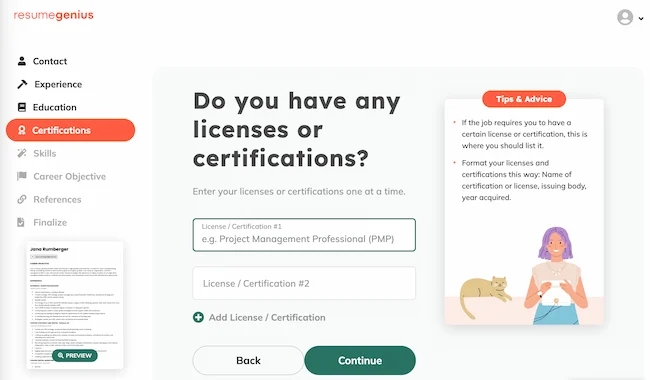
Resume Genius is undoubtedly one of the easiest and fastest free resume tools you have at your disposal. With a clean and easy-to-use interface, the tool walks you (speedily) through the sections of your resume, including education, work experience, and references.
Resume Genius provides you with easy fill-in-the-blank sections so you can have an impressive, comprehensive resume in no time.
Best For
Resume Genius is best for those looking for step-by-step guidance when creating a resume. The tool offers tips and advice at each stage of the process.
Resume Genius’ search options help you build an ATS-optimized resume that’s customized to fit your industry and position.
|
PROS
|
CONS
|
|
Easy to use interface
|
Free download is a .txt file; you must pay for a 14-day trial to download as a PDF or different format
|
|
URL for sharing and performance tracking
|
No option to upload an existing resume, so you must start from scratch each time, making it difficult to make updates
|
|
Can search for positions and choose from 50,000+ job description bullet points that relate to what you’re applying for
|
|
Available Resume Templates
Resume Genius has over 500 templates varying from Taj Mahal to Classic. Its resume builder tools let you scroll through different templates to see how each one looks with your information.
Verdict
This resume builder feels intuitive to use and offers helpful suggestions to polish your resume. But the template selection step can feel rushed, and you’ll need to pay a small fee to make the most of their wide range of templates.
3. Wepik: Best for Customizing Pre-made Resumes
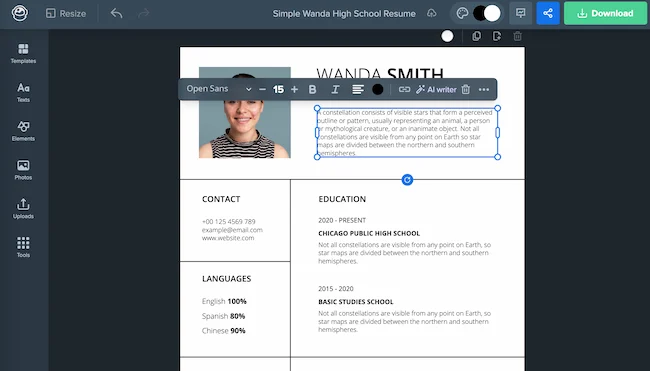
A lack of graphic design knowledge is no longer an issue thanks to Wepik, a user-friendly editing tool. This tool allows users to create the most professional and attractive visual branding documents with ease.
Once you’ve picked your perfect resume, import and complete your information into the template including your academic background, contact information, and business experience.
With one more click, download the document in your preferred format and you’ll be more than prepared to share your professional profile in minutes.
Best For
Wepik is a great tool for small businesses and individuals looking to create a quick, professional-looking resume and cover letter. Users will have access to completely free premium-level features within the online editor, such as a broad library of pictures, fonts, and graphic elements.
|
PROS
|
CONS
|
|
Free premium-level features
|
Fewer customization options for existing designs, which cannot be uploaded.
|
|
Intuitive and easy editing
|
You have to start from scratch or choose a template.
|
Available Resume Templates
This tool includes over 100 resume templates. Wepik also has thousands of ready-made templates for cover letters, name tags, cards, and more.
Verdict
Wepik makes it easy to plug your work experience into a beautiful template. Unlike the previous resume builders, it works more like a visual editor and doesn’t offer as much writing help as other tools. But this tool does offer AI writing help, and you can download your finished resume in PNG, JPG, or PDF formats.
4. My Perfect Resume: Best for Guided Resume Creation Help
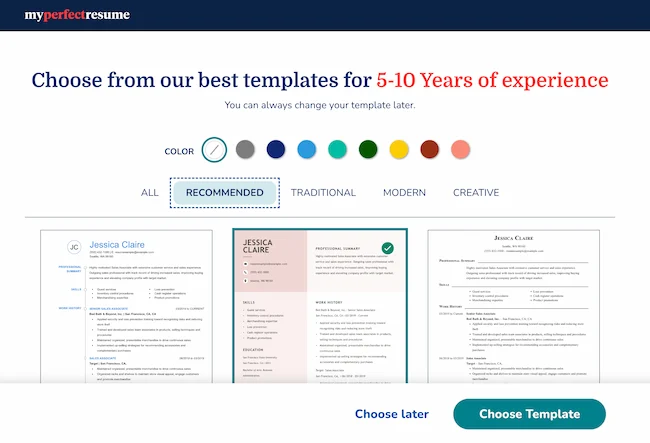
My Perfect Resume allows you to either start from scratch and input information into a blank template, or upload a pre-existing resume if you already have one. Plus, the tool offers you expert recommendations as you move throughout the process, including suggested phrases you can include for specific roles.
My Perfect Resume also enables you to include optional sections like certifications, accomplishments, and affiliations. This is vital, particularly if you’re just starting out, or switching industries. This tool is particularly useful if you’re applying for a creative role and want to add color or a unique design to your resume.
To use My Perfect Resume for free, click the”Download” button once you reach the final step of the builder instead of selecting “Finish Resume.” Then, choose “Plain Text (.txt)” to download your resume for free.
Best For
My Perfect Resume is excellent for those looking for guided help when creating their resumes. The tool recommends templates based on your experience level and provides expert recommendations for skills to include based on your job titles. Compared to other tools on the list, there are fewer customization options.
|
PROS
|
CONS
|
|
Recommends templates based on experience level
|
Fewer customization options
|
|
Provides expert recommendations for skills and job responsibilities based on job title
|
Some templates interfere with ATS
|
| |
Free download of a .txt file; you must pay $2.95 for a 14-day trial to download your resume as a PDF or Word document
|
Available Resume Templates
This tool has over 40 resume templates. It automatically shares template options based on how long you’ve been working. You can also filter templates by categories like Modern, Traditional, or Creative.
Verdict
This tool is super user-friendly and does a good job of anticipating and resolving challenges in the resume-making process. It also gives you a chance to experiment with templates before and after you’re done editing your resume. But to make the most of its optimized templates you’ll need to pay a fee.
5. Standard Resume: Best for Active LinkedIn Users
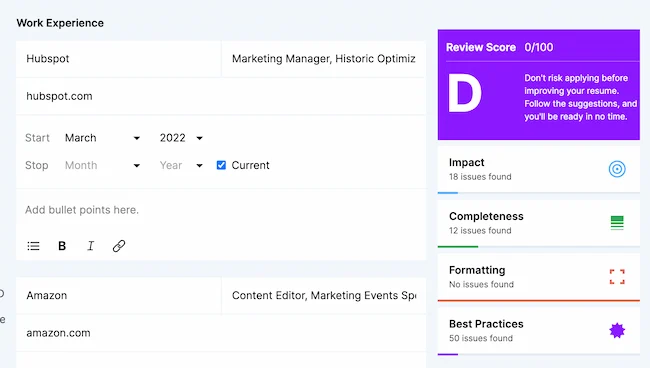
Standard Resume allows you to import your qualifications straight from LinkedIn, making it an ideal time-saver if your LinkedIn profile is up-to-date.
The white background and minimalist features enable you to focus on what really matters — your content. You can switch back and forth between “Write” and “Design” to see how your resume looks as you go along. To download it as a PDF you’ll need a paid plan, but you can share it online for free when you’re finished. Best of all, the tool also makes your resume mobile-responsive so that you can view it on your smartphone.
Best For
Standard Resume is great for LinkedIn users looking to quickly create an ATS-compatible resume. The tool uses your LinkedIn profile to automatically build a professional resume. Standard Resume also provides tips and best practices you can consult as you complete your resume draft.
|
PROS
|
CONS
|
|
Free
|
Limited customization options or design-focused tools
|
|
Easy import from existing LinkedIn profile
|
|
|
Minimalist, helping you focus on your experience and achievements
|
|
Available Resume Templates
Standard Resume offers 12 streamlined resume templates including Yew, Venables, and Cordova.
Verdict
The “Review Score” feature offers a clear score and set of recommendations to improve your resume before you start designing. It also offers an easy way to share an attractive resume online. But you’ll need a paid plan to download your resume as a PDF.
6. Canva: Best for Design Creativity and Expression
If you’re applying for a creative role or want a resume that truly lets you stand out, you might consider using one of Canva’s hundreds of free designer templates.
Canva’s selections are incredibly varied and unique, so you’ll undoubtedly find one you like, and inputting resume sections can be as easy as copy-and-paste.
Best For
Canva is best for those looking for resume design creativity and expression. Although not specifically designed for resume building, the tool offers a wide variety of templates, layouts, and designs to choose from when creating your resume.
|
PROS
|
CONS
|
|
Easy to use interface
|
No option to upload an existing resume, so you must start from scratch with each new resume
|
|
Hundreds of free designer templates
|
Difficult to edit design elements
|
|
Templates are categorized by industry
|
Canva’s PDF formatting can interfere with ATS
|
Available Resume Templates
Hundreds of templates, organized in categories, such as Graphic Design, Corporate, and Creative. This makes it easy to choose based on your preferred industry.
Verdict
This design tool can help you create a unique and visually-stunning resume. But if you’re looking for help formatting, writing, or editing your resume, you may want to look for another tool.
7. Indeed: Best for In-Platform Job Seekers
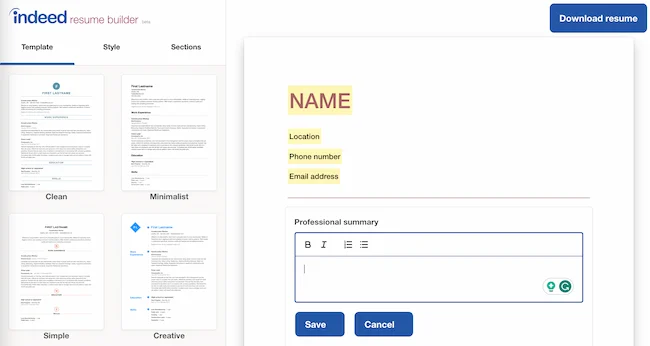
Creating an Indeed resume is an incredibly quick process. Best of all, the site allows you to automatically share your resume with employers on Indeed as soon as you’re finished. If you’ve already completed a resume, it’s still a good idea to upload it to the site for exposure to potential employers.
While Indeed doesn’t offer as many options for creativity as some of the others on this list, it’s an impressive option if you want to create a more traditional resume and start sharing it right away.
Just add your pre-written resume content, add it to a template, and download your resume as a PDF.
Best For
Indeed’s free resume builder is best for those looking to immediately jumpstart their job search after creating their resume. It guides you through the resume creation process with expert advice and prompts to help your resume catch employers’ attention. Resumes created using Indeed’s free resume builder are designed to be viewed and picked up by ATS.
|
PROS
|
CONS
|
|
Free
|
Only eight templates
|
|
Includes expert tips and advice
|
Limited design and customization options
|
|
Templates compatible with Applicant Tracking Systems (ATS)
|
Unable to import or upload an existing resume or LinkedIn profile
|
|
Automatically share your completed resume on the site for employers and recruiters to see
|
|
Available Resume Templates
This resume builder has eight simple templates, including Executive, Modern, and Minimalist.
Verdict
This resume builder is most useful if you’ve already used a resume template to write each section. It’s a quick way to make your resume look clean and professional, but if you’re looking for writing help or advice, you may want a more comprehensive tool.
8. Resume.com: Best for Minimalist Resume Creation
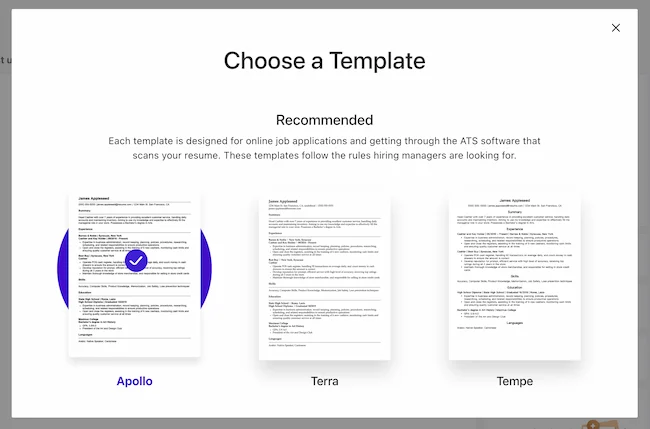
With Resume.com, you can build a beautiful resume in minutes. This tool is an excellent choice if you’re looking for recommendations on what to include in your resume. And this resume website has popular templates for various job categories to help you stand out from the competition.
To use this for free, when you’re at the last stage, you’ll see a pop-up that says to create an account — instead, just click “Skip for now.” Then, in the top right-hand corner, you can click the download button.
Best For
Resume.com is great for jobseekers looking to quickly create a professional resume. This 100% free resume builder provides resume examples to help you during the process.
|
PROS
|
CONS
|
|
Completely free
|
Limited options for design and customization
|
|
LinkedIn importing
|
No pre-written content
|
|
Share, print, and download in multiple formats
|
Minimal guidance for resume creation
|
Available Resume Templates
This tool offers 15 simple resume templates, including Apollo, Tempe, and Terra.
Verdict
This resume builder is easy to use and offers general tips to inspire your resume creation. That said, if you haven’t already written a resume you love, it doesn’t offer any personalized help to improve your resume.
9. Novoresume: Best for ATS-Friendly Resume Building
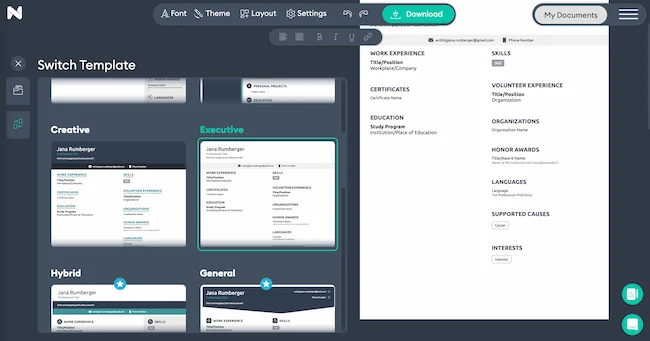
If you want a quick, modern, and professional resume, check out Novoresume. This tool is especially popular for creative industries such as graphic design, writing, or marketing. Its drag-and-drop editor helps you customize your resume to your needs.
Plus, its “Content Analyzer” tool can give you ideas for content, formatting, and design. This makes it an excellent resume builder if you’re changing careers or need an all-in-one resume tool.
Best For
Novoresume is an excellent choice if you want an ATS-friendly resume. The platform checks for relevant keywords and resume format for ATS system optimization. Its templates are eye-catching but still meet the strict ATS guidelines. Plus, Noveresume has a free ATS checker to scan your final document.
|
PROS
|
CONS
|
|
Applicant Tracking Systems (ATS) Optimized
|
Limited features in the free version
|
|
User-friendly interface
|
Some features are only available with premium pricing
|
|
Modern design and formatting
|
Limited options for layout changes
|
Available Resume Templates
This tool offers eight free resume templates, and more with the premium version.
Verdict
This tool offers a range of features to create a well-designed and easy-to-read resume that you can quickly download to PDF. But many features come with premium pricing, and there’s no option to upload an existing resume for editing.
10. VisualCV: Best for Multimedia Resumes
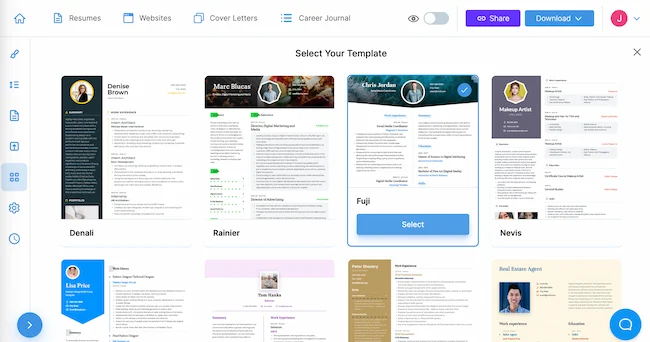
Creative industries like photography, advertising, and design often like to see a resume with visual appeal. While many resume builders offer fetching designs, Visual CV offers a drag-and-drop editor to create a truly custom resume.
This tool also gives you a chance to track the performance of your online resume and multimedia extras. This lets you update your resume and attachments with data-driven ideas.
Best For
Besides an appealing resume, creatives often submit multimedia applications with an online portfolio, videos, images, or links. This resume builder makes it simple to add media directly to your resume, adding interaction and visual engagement.
|
PROS
|
CONS
|
|
Multimedia resume options
|
Primarily for creative professionals
|
|
Customizable drag and drop editing
|
Limited features in the free version
|
|
Applicant Tracking Systems (ATS) optimized templates
|
Some complicated or difficult-to-use features
|
Available Resume Templates
This tool has over 20 attractive templates, including Denali, Quartz, and Fuji.
Verdict
This resume builder is a great way to create an attractive and professional resume, with loads of premium choices. While technically a free tool, without upgrading to a paid account, you’ll have a large watermark on your new resume PDF.
11. CakeResume: Best for Resumes With an Online Portfolio

CakeResume is one of the best resume websites for creative resumes. It offers customizable templates and a rich media editor to embed videos, images, and PDF files directly into your resume. It also includes resume optimization for ATS.
Make your resume stand out without coding experience using this simple interface and drag-and-drop tools. Once you’ve designed your resume you can preview to make sure your final resume is formatted correctly, then click “Download PDF” to save your new resume.
Best For
This resume builder is for job seekers who want to add an online portfolio, video, quote, or slideshow to their resume. Your online portfolio can include recent projects to help you stand out from other candidates and get to the job interview stage.
|
PROS
|
CONS
|
|
Create a resume with an online portfolio
|
Limited to one free resume
|
|
User-friendly drag-and-drop design features
|
Limited features with the free version
|
|
ATS optimization
|
|
Available Resume Templates
CakeResume offers 10+ multimedia-friendly resume templates.
Verdict
This resume builder is excellent for creating resumes that incorporate other media or important links. But it doesn’t include tips for writing, so it’s useful to use a resume template for drafting your resume before using this resume design tool.
12. Resume-Now: Best for Time-Saving Resume Creation
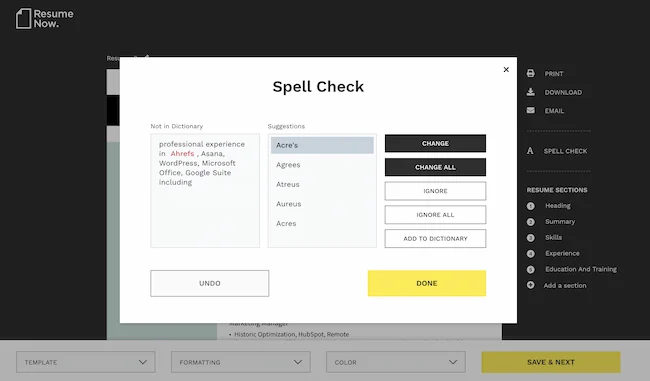
Creating a custom resume for each job application is ideal, but it can also be a headache because of the time drafting a resume can take. But Resume-Now is an intuitive resume builder with a ton of customization choices. It offers key phrase and skill suggestions for both ATS and the recruiter you need to impress.
Smart templates, a clear interface, and useful advice make this a great tool for resume building in no time. To download your resume, instead of clicking “Save and Next” at the bottom of the screen, click “Download.” Then, select Plain Text to download your resume for free. Other resume download formats will mean a charge.
Best For
Resume-Now uses powerful templates and useful tools to speed up the resume creation process. This makes it perfect for job seekers who want to create a personalized resume for each application. You can also make your resume interactive and track resume engagement once you’ve finished.
|
PROS
|
CONS
|
|
Pre-written content and tips for different job industries
|
May not offer depth and detail for technical or niche positions
|
|
User-friendly interface
|
Limited customization compared to other resume builders
|
|
Easy to customize
|
Free download is a .txt file; you must pay for a 14-day trial to download as a PDF or Word document
|
Available Resume Templates
Resume-Now offers over 30 attractive resume templates.
Verdict
This is a comprehensive tool for efficient and effective resume building. But you lose the unique quality of the templates when using the free version only.
13. ResumeNerd: Best for Resume Writing Help
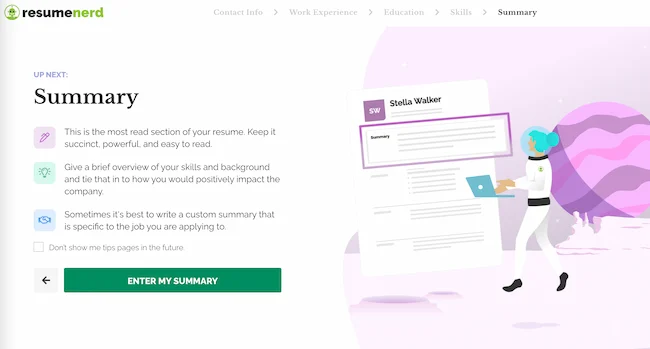
ResumeNerd is a super helpful tool for new job seekers creating resumes. It offers dozens of pre-written bullet points, expert resume coaching, and customizable designs. If you’re not sure how to write a resume, this could be the resume builder for you.
Another bonus this builder offers is industry-specific resume samples. That said, if you’re looking for a free tool, this free download is .txt format only.
Best For
This resume builder is a top choice for help with writing a resume. Its features include writing suggestions and pre-written sections for highlighting skills and experience. This tool is also super user-friendly for creating quick and polished resumes.
|
PROS
|
CONS
|
|
Pre-written phrases and bullet points
|
Limited features in the free version
|
|
Step-by-step resume-building instruction
|
Better for entry-level job seekers than experienced professionals
|
|
24/7 customer support
|
Some features are only available on the premium version
|
Available Resume Templates
This resume builder offers 13 unique templates, including Hospitality, Impresa, and Heron.
Verdict
ResumeNerd is a helpful resume builder for people building a first resume. But the suggestions and tips may not be as useful for people with more work history.
14. Hloom: Best for Resume Templates
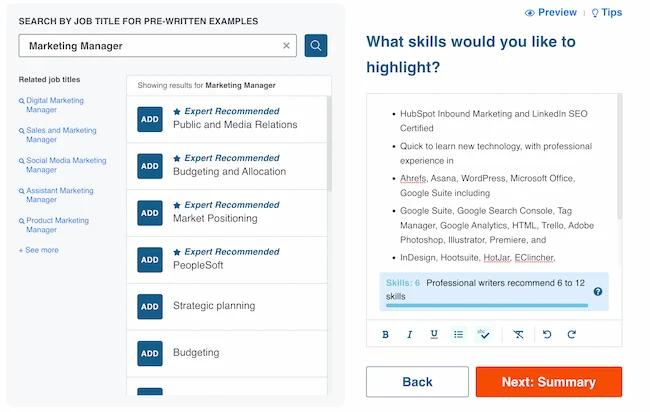
Whether you need a modern, creative, or traditional template, Hloom can help job seekers in any industry. This customizable and easy-to-use resume builder can help you create an eye-catching and ATS-friendly resume or CV.
This tool is comprehensive too — you can add fonts or images to amp up your design or use the resume writing tips to improve your resume.
Best For
Hloom offers a selection of over 400 professional resume templates. You can edit any template to your specific needs, saving time and effort. This platform also offers cover letter and reference templates to keep your personal branding consistent across your job applications.
|
PROS
|
CONS
|
|
400+ resume templates
|
Free downloads are limited to .txt files
|
|
Industry-specific templates
|
No multimedia support
|
|
Drag-and-drop customization features
|
|
Available Resume Templates
HLoom has over 400 templates available, and offers categories to help you find the best template for your needs.
Verdict
HLoom is a simple and straightforward resume builder that offers a range of templates and tips for resume creation. Like many other tools, users need to pay to get all the benefits of designed templates, as it limits free downloads to Plain Text files.
Building a resume can feel like you’re staring at a blank canvas. But with an online resume builder, you can get recommendations and build a beautiful document that will stand out without needing a graphic design degree.
What’s the best resume builder?
The best resume builder for you will vary depending on your needs.
If you prefer a tool that guides you through the process of creating a resume, we recommend using a builder that provides tips and suggestions. If you prefer a resume builder that automatically creates a resume, we recommend a tool that pulls information from LinkedIn. If you prefer having creative freedom when building your resume, we recommend using a tool that includes customization options.
Choose the resume builder that meets your needs and fits your industry and personal style, and you’ll be well on your way to earning a second look from hiring managers.
Editor’s note: This post was originally published in March 2019 and was updated for comprehensiveness.



![]()








![Download Now: The State of AI in 2023 [Free Report]](https://i4lead.com/wp-content/uploads/2023/06/3e25e192-30c3-40c1-a7da-a4d054c9e157.png)


















![→ Download Now: 12 Resume Templates [Free Download]](https://i4lead.com/wp-content/uploads/2023/06/4ec95757-585e-40cf-9189-6b3885074e98.png)
















![Download Now: Market Research Templates [Free Kit]](https://i4lead.com/wp-content/uploads/2023/06/6ba52ce7-bb69-4b63-965b-4ea21ba905da.png)








![Download 10 Excel Templates for Marketers [Free Kit]](https://i4lead.com/wp-content/uploads/2023/06/9ff7a4fe-5293-496c-acca-566bc6e73f42.png)


 In this Excel XLookup example, we used XLookup to find out the grade for a particular student. So, the lookup_value was the student’s name (“Ruben Pugh”).
In this Excel XLookup example, we used XLookup to find out the grade for a particular student. So, the lookup_value was the student’s name (“Ruben Pugh”). Now, let’s say we want to determine whether any students had an attendance rate of 70%. But we also want to know the next closest attendance rate if 70% does not exist in the dataset.
Now, let’s say we want to determine whether any students had an attendance rate of 70%. But we also want to know the next closest attendance rate if 70% does not exist in the dataset.
